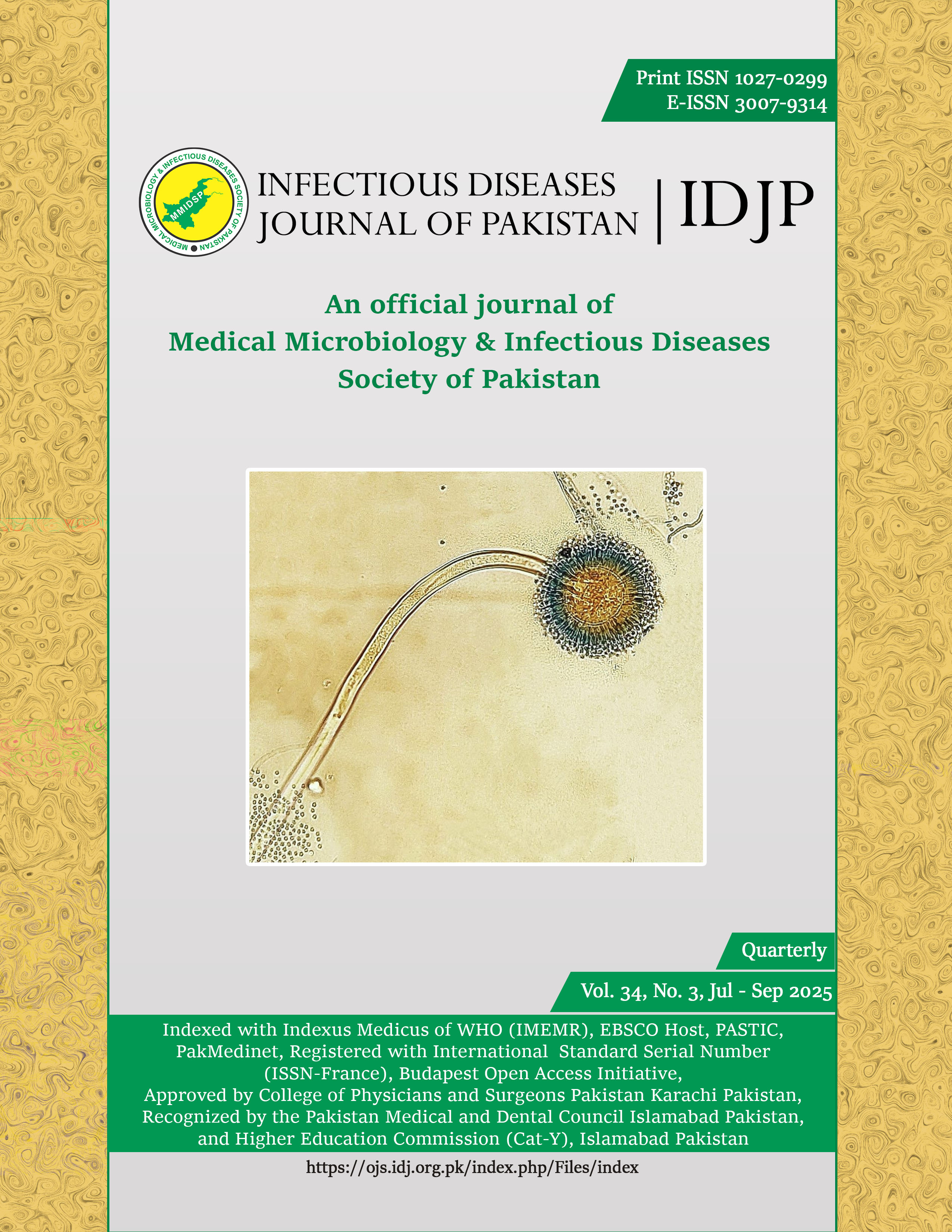Diagnostic accuracy of colistin agar test medium for the detection of colistin resistant gram-negative rods directly from positive blood cultures
DOI:
https://doi.org/10.61529/idjp.v34i3.437Abstract
Background: Colistin (polymyxin E) is an important treatment choice against infections with multidrug-resistant (MDR) Gram-negative rods (GNRs). The mechanism of its activity is its bactericidal action, which involves disrupting the integrity of the bacterial outer membrane. Resistance is usually caused by changes in the lipid A portion of lipopolysaccharides, which reduce the affinity of colistin for binding, leading to a loss of antimicrobial activity.
Material and Methods: Positive blood culture bottles containing Gram-negative rods after Gram staining were directly inoculated onto CAT medium supplemented with 4 µg/mL colistin. Growth after 18–24 hours of incubation at 37 °C indicated colistin resistance. The outcomes were compared with conventional culture and susceptibility testing (Vitek-2, CLSI 2024). Species that are intrinsically resistant were excluded. Known colistin-resistant and -susceptible bacterial strains were used for quality control.
Results: The CAT medium was 85.13% sensitive, 83.81% specific, and 84.66% diagnostically accurate in identifying colistin-resistant Gram-negative rods. With an ROC AUC of 0.845 (95% CI: 0.795–0.895), it demonstrated good overall diagnostic performance, indicating its reliability, precision, and high discriminatory power compared with conventional methods.
Conclusion: The CAT medium has good diagnostic performance for the direct detection of colistin-resistant Gram-negative rods in positive blood cultures.
Keywords: Colistin, Gram-negative bacteria, Gram-negative rods.
References
Alara JA, Alara OR. An overview of the global alarming increase of multiple drug resistant: a major challenge in clinical diagnosis. Infect Disord Drug Targets. 2024; 24(3): e250723219043.
DOI: https://doi.org/10.2174/18715265236662307251039 02
Fongang H, Mbaveng AT, Kuete V. Global burden of bacterial infections and drug resistance. Adv Botanical Res. 2023; 106: 1-20. DOI: https://doi.org/10.1016/bs.abr.2022.08.001
Okenwa SC, Ugwuezea JC, Ekweozor CA, Anunwa IG, Nwachukwu JC, Nwankwo FM, et al. Prevalence and molecular characterization of colistin resistance in gram-negative bacteria from Nigeria Hospitals: A systematic review. Asian J Res Med Pharma Sci. 2024; 13 (4): 137-159. DOI: https://doi.org/10.9734/ajrimps/2024/v13i4281
Rubens RS, Arruda ID, Almeida RM, Nóbrega YK, Carneiro MD, Dalmolin TV. Challenges in the detection of Polymyxin Resistance: From Today to the future. Microorganisms. 2024; 12(1): 101. DOI: https://doi.org/10.3390/microorganisms12010101
Gogry FA, Siddiqui MT, Sultan I, Haq QM. Current update on intrinsic and acquired colistin resistance mechanisms in bacteria. Front Med. 2021; 8: 677720. DOI: https://doi.org/10.3389/fmed.2021.677720
Syed B, Ishaque S, Imran A, Muslim O, Khalid S, Siddiqui AB. Emergence of colistin-resistant gram-negative rods in intensive care units: A cross-sectional study from a developing country. SAGE Open Med. 2022; 10: 20503121221132358. DOI: https://doi.org/10.1177/20503121221132358
Khan RM, Nadeem A, Iqbal MS, Muhammad F, Kiran T, Ali A, et al. The prevalence of carbapenem and colistin-resistant gram-negative bacteria isolated from hospital-admitted patients with bacteremia. J Microbiol Sci. 2024 30; 3(01): 30-5. DOI: https://doi.org/10.38211/jms.2024.03.69
Mondal AH, Khare K, Saxena P, Debnath P, Mukhopadhyay K, Yadav D. A review on colistin resistance: an antibiotic of last resort. Microorganisms. 2024; 12(4): 772. DOI: https://doi.org/10.3390/microorganisms12040772
Elbehiry A, Marzouk E, Abalkhail A, Abdelsalam MH, Mostafa ME, Alasiri M, et al. Detection of antimicrobial resistance via state-of-the-art technologies versus conventional methods. Front Microbiol. 2025; 16: 1549044.
DOI: https://doi.org/10.3389/fmicb.2025.1549044
Sujatha SR, Deepashree R, Tejashree A, Sai S. Evaluation of colistin broth disk elution and colistin agar test: a study from tertiary care hospital, South India. J Pure Appl Microbiol. 2022 Jun 1;16(2):885-90. DOI: https://doi.org/10.22207/JPAM.16.2.08
Ali S, Hussain W, Ahmad F, Afzal RK, Mirza IA, Sarwar M. Colistin Agar; Evaluation of a novel diagnostic approach to detection of colistin resistance. Pak Armed Forces Med J. 2022; 71(6): 2249-52. DOI: https://doi.org/10.51253/pafmj.v71i6.7223
Abu-El-Azayem AK, Dwedar RA, Nashaat N, Shash RY. Comparative evaluation of colistin susceptibility testing using agar dilution and broth microdilution in multidrug-resistant and extensively drug-resistant gram-negative isolates. Egyptian J Med Microbiol. 2023; 32(3): 109-15. DOI: https://doi.org/10.21608/ejmm.2023.310119
Clinical Lab. Standard Institute CLSI (2024). Performance Standards for Antimicrobial Susceptibility Tests. 33rd. CLSI supplement M100. Clinical and Laboratory Standards Institute, USA. Avaiable from: https://tinyurl.com/yvkvw6jp
Kazaz I, Karaman GC, Karakus H, Kaya S, Hosbul T. Evaluation of colistin susceptibility by four phenotypic methods compared to broth microdilution in multidrug-resistant Klebsiella pneumoniae. BMC Microbiol. 2025; 25(1): 415. DOI: https://doi.org/10.1186/s12866-025-04121-1
Furqan W, Ali S, Usman J, Hanif F, Naeem A, Nasrullah A, et al. Assessing Colistin resistance by phenotypic and molecular methods in carbapenem-resistant Enterobacterales in a tertiary care hospital in Pakistan. Infect Drug Resist. 2022: 5899-904. DOI: https://doi.org/10.2147/IDR.S376490
Alhamwi R, Öksüz L. Detection of colistin resistance via four methods in multidrug-resistant Gram-negative rods isolated from blood cultures. J Infect Developing Countries. 2022; 16(11): 1748-56. DOI: https://doi.org/10.3855/jidc.16480
Uzairue LI, Rabaan AA, Adewumi FA, Okolie OJ, Folorunso JB, Bakhrebah MA, et al. Global prevalence of colistin resistance in Klebsiella pneumoniae from bloodstream infection: a systematic review and meta-analysis. Pathogens. 2022; 11(10): 1092. DOI: https://doi.org/10.3390/pathogens11101092
Marrs EC, Milburn O, Eltringham GJ, Fenwick DJ, Orenga S, Hazırolan G, et al. The use of CHROMID® colistin R for the detection of colistin-resistant gram-negative bacteria in positive blood cultures. Antibiotics. 2024; 13(3): 246.
DOI: https://doi.org/10.3390/antibiotics13030246
Rana AH, Naqvi SH, Afzal RK, Ahmad F, Imtiaz A, Hussain A. Diagnostic accuracy of CHROMagar™ COL-APSE medium for the detection of colistin resistant Gram-negative rods directly from positive blood cultures. Infect Dis J Pak. 2025; 34(2): 87-92. DOI: https://doi.org/10.61529/idjp.v34i2.398
World Health Organization. Global antimicrobial resistance and use surveillance system (GLASS) report 2022. World Health Organization. 2022. Available from: https://iris.who.int/bitstream/handle/10665/381094/9789240108127-eng.pdf?sequence=1
Downloads
Published
How to Cite
Issue
Section
License
Copyright (c) 2025 Editor Office

This work is licensed under a Creative Commons Attribution-NonCommercial 4.0 International License.



